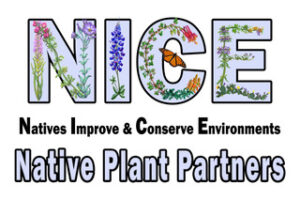 Texas is a large and diverse state. Plants that work for one region may not always be the best choice in a different region. The Native Plant Society of Texas created the NICE Native Plant Partners program to help nurseries offer natives that are right for the local environment.
Texas is a large and diverse state. Plants that work for one region may not always be the best choice in a different region. The Native Plant Society of Texas created the NICE Native Plant Partners program to help nurseries offer natives that are right for the local environment.
Committees for Native Plant Partners are run by local chapters and create the Plant of the Season lists in cooperation with wholesalers in order to assure availability and in cooperation with participating local nurseries. The Native Plant Society of Texas then helps promote the Plant of the Season through our website and newspaper articles, signs at the point of sale and other means. Information sheets on the plant are available at the nursery along with care and planting instructions. The following Dallas county nurseries are currently participating in our program.
Summer 2023 Plant of the Season: Frogfruit, Phyla nodiflora (Lippia nodiflora)

Frogfruit, Phyla nodiflora (Lippia nodiflora), also called Texas Frogfruit,
or Sawtooth Frogfruit, is a member of the verbena family.
Frogfruit is a rapid grower and an excellent long-lived perennial groundcover.
Handouts and information
2023-06 NICE Frogfruit Information Sheet_Dallas (WORD DOC 6.14 MB)
2023-06 NICE Frogfruit Information Sheet_Dallas (PDF 173 KB)
Featured NICE! Plants of Previous Seasons
2023, Spring – Crossvine, Bignonia capreolata (PDF 99 KB)
2021, Winter-Spring – Prairie Verbena, Glandularia bipinnatifida (PDF 163 KB)
2021, Spring-Summer – Purple Passionvine, Passiflora incarnata (PDF 306 KB)
2019, Winter-Spring – Bluebonnet – Lupinus texensis (PDF 156 KB)
2019, Spring-Summer – Purple Coneflower – Echinacea purpurea (PDF 156 KB)
The Dallas Chapter is currently partnering with these area nurseries:
North Haven Gardens – www.nhg.com/texas-natives/
Randy Johnson Organics – https://www.facebook.com/profile.php?id=100063160752141
Redenta’s – https://redentas.com/


